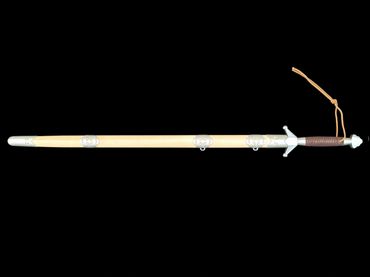
The "IMMORTAL" Wudang Jian - 1931 CHINA
The "Immortal" Wudang Jian
Designed by General Li LingLin, the “Immortal Sword Saint” 劍仙
For a functioning sword, ideally it should be a steel sword with some springiness to it. It should be either too long or too heavy, or it will not be suitable. The center of balance needs to be nearer to the handle, otherwise it will not be easy to use.
The Wudang sword hilt is different from the norm, the corners angled upward for the special purposes of catching the opponent’s sword and taking advantage of his force to injure his body or hand.
Long form
Blade length: 86 cm (34")
Hilt plus hand guard length: 22.5 cm (8.86")
Total length: 108.5 cm (42.7")
Width at hand guard: 29.5 mm,
Width at tip: 20 mm
Thickness at hand guard:: 6.3 mm
Thickness at the tip: 2.3 mm
Blade Profile: diamond 4 surfaces
Gentle tapering
Sword only weight: 804 g (1 lb. 12.4 oz)
POB: approx. 13 cm (5.11")
from the base of the hand guard
GB 60Si2MnA High Carbon Manganese Spring Steel
(Compare to AISI/SAE 5160 spring steel)
Element % 60Si2MnA AISI/SAE 5160
Carbon 0.56-0.64 0.56-0.61
Silicon 1.60-2.00 0.15-0.35
Manganese 0.60-0.90 0.75-1.00
Phosphorus <=0.030 <=0.035
Sulfur <=0.030 <=0.040
Chromium <=0.35 0.70-0.90
Nickel <=0.35 <=0.25
Superior heat treatment:
Hardness 54-55 HRC.
Blade rebounds to true after bending,
Hand polish to smooth soft shine and sword sharp edge.
Fittings
Industrial grade precision cast stainless steel fittings.
The Wudang sword hilt is different from the norm, the corners angled upward for the special purposes of catching the opponent’s sword and taking advantage of his force to injure his body or hand.
The pommel is a simplified classic cumulus cloud shape.
Scabbard
Magnolia wood decked with stainless steel scabbard mounts.
Fit and finish
We perfected the fit and finish of our swords and the final assembly is meticulously performed by our senior craft masters. It takes a skill craftsman one whole working day to assemble our sword to a precision fit.
Sword dynamics GRAPH of WUDANG Jian (LONG vs compact)

Sword Dynamics is first conceived by Peter Johnsson to objectively record the dynamics properties of medieval swords he encountered.
To learn how to interpret the Sword Dynamics Graph, click here!
Sword Dynamics was implemented by applied mathematician Dr. Vincent Le Chevalier as a free Weapons Dynamics Computer.
To learn how to measure basic data for the Weapons Dynamics Computer click here!
The "IMMORTAL" Wudang Jian
The "IMMORTAL" Wudang Jian














Immortal wudang jian review
Immortal Wudang Jian review
Preview of Immortal Wudang Jian

the “IMMORTAL Sword Saint” 劍仙 - General Li Jinglin,
The “Immortal Sword Saint” of Wudang Jian - General Li Jinglin
Few individuals come to be known as both a warlord and a “sword saint.” Even by the standards of China’s tumultuous 1920s, the carving out of two such notable public personas was an impressive achievement. Yet General Li Jinglin managed to leave his stamp on both Chinese politics and the development of the nation’s traditional martial arts.
Still, there can be no doubt that Li Jinglin (1885 – 1931) deserves more attention than he typically receives. Beyond his role as a political figure in the turbulent warlord era, he was a dedicated martial artist. Li studied with several important teachers, tirelessly promoting both Yang style Taijiquan and the Wudang sword tradition. When not exchanging techniques with China’s most famous martial artists he was bringing them together as he created one martial arts association after another, eventually becoming a chief architect of the KMT’s Guoshu movement.
See the full article here
For the Wudang 2 person training form developed by Li JingLin, see here

The key in sword practice is that your body moves like a swimming dragon, never coming to a halt. After practicing over a long period, your body will unite with your sword, then your sword will merge with your spirit. There will be no sword anywhere, and everywhere there will be a sword. When you are able to understand this principle, you are almost there.
– Li Jinglin of Guang chuan

WUDANG TWO PERSON training Set
Antique Wudang Jian



Cookie Policy
This website uses cookies. By continuing to use this site, you accept our use of cookies.